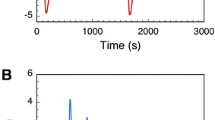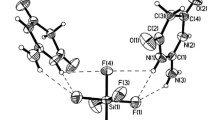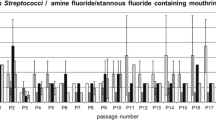Abstract
One of the major effects of fluoride on oral bacteria is a reduction in acid tolerance, and presumably also in cariogenicity. The reduction appears to involve transport of protons across the cell membrane by the weak acid HF to dissipate the pH gradient, and also direct inhibition of the F1F0, proton-translocating ATPases of the organisms, especially for Streptococcus mutans. This direct inhibition by fluoride was found to be dependent on aluminum. The dependence on aluminum was indicated by the protection against fluoride inhibition afforded by the Al-chelator deferoxamine and by loss of protection after addition of umolar levels of Al3+, which were not inhibitory for the enzyme in the absence of fluoride. The F1 form of the enzyme dissociated from the cell membrane previously had been found to be resistant to fluoride in comparison with the F1F0 membrane-associated form. However, this difference appeared to depend on less aluminum in the F1 preparation in that the sensitivity of the F1 enzyme to fluoride could be increased by addition of umolar levels of Al3+. The effects of Al on fluoride inhibition were apparent when enzyme activity was assayed in terms of phosphate release from ATP or with an ATP-regenerating system containing phosphoenolpyruvate, pyruvate kinase, NADH and lactic dehydrogenase. Also, Be2+ but not other metal cations, e.g. Co2+, Fe2+, Fe3+, Mn2, Sn2+, and Zn2+, served to sensitize the enzyme to fluoride inhibition. The differences in sensitivities of enzymes isolated from various oral bacteria found previously appeared also to be related to differences in levels of Al. Even the fluoride-resistant enzyme of isolated membranes of Lactobacillus casei ATCC 4646 could be rendered fluoride-sensitive through addition of Al3+. Thus, the F1F0 ATPases of oral bacteria were similar to E1E2 ATPases of eukaryotes in being inhibited by Al-F complexes, and the inhibition presumably involved formation of ADP-Al-F sup-inf3 complexes during catalysis at the active sites of the enzymes.
Similar content being viewed by others
References
Ackrill P, Day JP (1984) Therapy of aluminum overload (II). Contrib Nephrol 38:78–80
Bender GR, Marquis RE (1987) Membrane ATPases and acid tolerance of Actinomyces viscosus and Lactobacillus casei. Appl Environ Microbiol 53:2124–2128
Bender GR, Sutton SVW, Marquis RE (1986) Acid tolerance, proton permeabilities, and membrane ATPases of oral streptococci. Infect Immun 53:331–338
Duckworth RM, Morgan SN, Murray AM (1987) Fluoride in saliva and plaque following use of fluoride-containing mouthwashes. J Dent Res 66:1730–1734
Ekstrand J, Fejerskov O, Silverman LM (1988) Fluoride in dentistry. Munksgaard, Copenhagen
Geddes DAM, Rolla G (1988) Fluoride in saliva and dental plaque. In: Ekstrand J, Fejerskov O, Silverman LM (eds) Fluoride in dentistry. Munksgaard, Copenhagen
Gutknecht J, Walter A (1981) Hydrofluoride and nitric acid transport through lipid bilayer membranes. Biochim Biophys Acta 644:153–156
Kleber CJ, Putt MS (1984) Aluminum and dental caries a review of the literature. Clin Prevent Dent 6:14–25
Lunardi J, Dupuis A, Garin J, Issartel J-P, Michel L, Chabre M, Vignais PV (1988) Inhibition of H+-transporting ATPase by formation of a tight nucleoside diphosphate-fluoroaluminate complex at the catalytic site. Proc Natl Acad Sci USA 85:8958–8962
Marquis RE (1990) Diminished acid tolerance of plaque bacteria caused by fluoride. J Dent Res 69:672–675
Missiaen L, Wuytack F, De Smedt H, Vrolix M, Casteels R (1988) AlF4 reversibly inhibits ‘P’-type cation-transport ATPases, possibly by interacting with the phosphate-binding site of the ATPase. Biochem J 253:827–833
Robinson JD, Davis RL, Steinberg M (1986) Fluoride and beryllium interact with the (Na+K)-dependent ATPase as analogs of phosphate. J Bioenerg Biomembr 18:521–531
Senior AE, Downie JA, Cox GB, Gibson F, Langman L, Fayle DRH (1979) The uncA gene codes for the alpha-subunit of the adenosine triphosphatase of Escherichia coli. Biochem J 180:103–109
Sternweis PC, Gilman AG (1982) Aluminum: A requirement for activation of the regulatory component of the adenylate cyclase by fluoride. Proc Natl Acad Sci USA 79:4888–4891
Sutton SVW, Bender GR, Marquis RE (1987) Fluoride inhibition of the proton-translocating ATPases of oral bacteria. Infect Immun 55:2597–2603
Womack FC, Colowick SP (1979) Proton-dependent inhibition of yeast and brain hexokinases by aluminum in ATP preparations. Proc Natl Acad Sci USA 76:5080–5084
Author information
Authors and Affiliations
Rights and permissions
About this article
Cite this article
Sturr, M.G., Marquis, R.E. Inhibition of proton-translocating ATPases of Streptococcus mutans and Lactobacillus casei by fluoride and aluminum. Arch. Microbiol. 155, 22–27 (1990). https://doi.org/10.1007/BF00291269
Received:
Accepted:
Issue Date:
DOI: https://doi.org/10.1007/BF00291269




